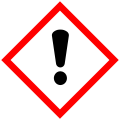1,2-Difluorethan
| Strukturformel | |||||||||||||||||||
|---|---|---|---|---|---|---|---|---|---|---|---|---|---|---|---|---|---|---|---|
 | |||||||||||||||||||
| Allgemeines | |||||||||||||||||||
| Name | 1,2-Difluorethan | ||||||||||||||||||
| Andere Namen | HFC-152 | ||||||||||||||||||
| Summenformel | C2H4F2 | ||||||||||||||||||
| Externe Identifikatoren/Datenbanken | |||||||||||||||||||
| |||||||||||||||||||
| Eigenschaften | |||||||||||||||||||
| Molare Masse | 66,05 g·mol−1 | ||||||||||||||||||
| Aggregatzustand | flüssig[1] | ||||||||||||||||||
| Dichte | 0,913 g·cm−3 (19 °C)[2] | ||||||||||||||||||
| Schmelzpunkt | |||||||||||||||||||
| Siedepunkt | 26 °C[1] | ||||||||||||||||||
| Löslichkeit | gut löslich in Benzol und Chloroform[1] | ||||||||||||||||||
| Brechungsindex | 1,28 (25 °C)[2] | ||||||||||||||||||
| Sicherheitshinweise | |||||||||||||||||||
| |||||||||||||||||||
| Treibhauspotential | 20 (bezogen auf 100 Jahre)[5] | ||||||||||||||||||
| Wenn nicht anders vermerkt, gelten die angegebenen Daten bei Standardbedingungen (0 °C, 1000 hPa). Brechungsindex: Na-D-Linie, 20 °C | |||||||||||||||||||
1,2-Difluorethan ist eine chemische Verbindung aus der Gruppe der Fluorkohlenwasserstoffe. Unter den Bezeichnungen R152 und HFC-152 wurde der Stoff vorwiegend als Kältemittel eingesetzt. Er ist ein Isomer von 1,1-Difluorethan (HFC-152a).
Gewinnung und Darstellung
1,2-Difluorethan kann durch Reaktion von Ethen mit Fluor gewonnen werden.[6] Eine weitere Darstellungsmethode ist die Addition von Fluor an Ethen mittels Xenondifluorid, wobei allerdings ein Produktgemisch aus 45 % 1,2-Difluorethan, 35 % 1,1-Difluorethan und 1,1,2-Trifluorethan entsteht.[7][8]
Eigenschaften
In flüssiger Form ist 1,2-Difluorethan gut löslich in Benzol und Chloroform ist.[1] Sie liegt hauptsächlich in der cis-Form vor.[9][10] In fester Form nahe ihrem Schmelzpunkt hat die Verbindung eine monokline Kristallstruktur mit der Raumgruppe C2/m (Raumgruppen-Nr. 12), wobei eine zweite Form mit einer orthorhombischen Kristallstruktur mit der Raumgruppe Raumgruppe P212121 (Raumgruppen-Nr. 19) existiert.[3]
Verwendung
1,2-Difluorethan wurde als Kältemittel verwendet.
Einzelnachweise
- ↑ a b c d William M. Haynes: CRC Handbook of Chemistry and Physics, 94th Edition. CRC Press, 2016, ISBN 978-1-4665-7115-0, S. 67 (eingeschränkte Vorschau in der Google-Buchsuche).
- ↑ a b Eintrag zu 1,2-Difluoroethane in der Hazardous Substances Data Bank (via PubChem), abgerufen am 4. März 2018.
- ↑ a b Floris Akkerman, Jürgen Buschmann, Dieter Lentz, Peter Luger, Eva Rödel: Crystal and molecular structure of 1,2-difluoroethane and 1,2-diiodoethane. In: Journal of Chemical Crystallography. 33, S. 969–975, doi:10.1023/A:1027494101785.
- ↑ a b synquestlabs:1,2-Difluoroethane ( vom 5. November 2019 im Internet Archive), abgerufen am 5. November 2019
- ↑ G. Myhre, D. Shindell et al.: Climate Change 2013: The Physical Science Basis. Working Group I contribution to the IPCC Fifth Assessment Report. Hrsg.: Intergovernmental Panel on Climate Change. 2013, Chapter 8: Anthropogenic and Natural Radiative Forcing, S. 24–39; Table 8.SM.16 (ipcc.ch [PDF; 15,5 MB]).
- ↑ R. H. Hauge, S. Gransden, J. L. F. Wang, J. L. Margrave: Studies of the reactions of molecular fluorine with methane, acetylene, ethylene, allene, and other small hydrocarbons in matrices at low temperatures. In: Journal of the American Chemical Society. 101, 1979, S. 6950–6954, doi:10.1021/ja00517a027.
- ↑ e-EROS Encyclopedia of Reagents for Organic Synthesis, 1999–2013, John Wiley and Sons, Inc., Eintrag für Xenon(II)-fluorid, abgerufen am 20. Januar 2018.
- ↑ Yang,N.-C.; Shieh, T.-C.; Feit, E.D.; Chernick, C.L.: Reactions of xenon fluorides with organic compounds; in: J. Org. Chem. 35, 1970, S. 4020–4024, doi:10.1021/jo00837a001.
- ↑ Peer Kirsch: Modern Fluoroorganic Chemistry Synthesis, Reactivity, Applications. John Wiley & Sons, 2006, ISBN 3-527-60419-7, S. 243 (eingeschränkte Vorschau in der Google-Buchsuche).
- ↑ Alexander V. Benderskii, Charles A. Wight: Conformational Isomerization of 1,2-Difluoroethane in Solid Argon: Cage-Modified Reaction Barriers. In: The Journal of Physical Chemistry. 100, 1996, S. 14958–14961, doi:10.1021/jp961519d.
Auf dieser Seite verwendete Medien
Global harmonisiertes System zur Einstufung und Kennzeichnung von Chemikalien (GHS): Piktogramm für giftige / toxische Chemikalien
Valenzstrichformel von 1,2-Difluorethan
Globally Harmonized System of Classification and Labelling of Chemicals (GHS) pictogram for flammable substances





